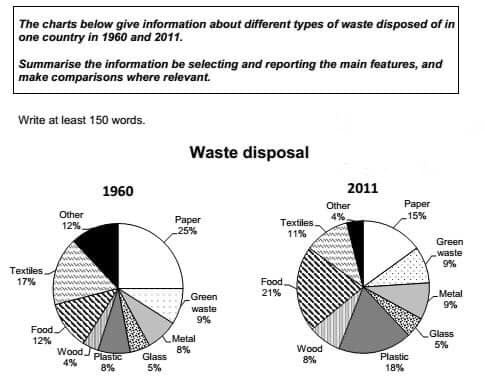yentk
Jul 13, 2022
Writing Feedback / The two pie charts illustrate how different kinds of waste released in one country (1960 - 2011) [2]
The two pie charts illustrate how different kinds of waste released in one country between 1960 and 2011.
Overall, there was a significant growth in the proportion of garbage coming from food, wood, metal and plastics; meanwhile, opposite trends can be seen in the figures of glass, green waste, paper, textiles and other waste. Moreover, in 1960, paper waste accounted for the majority of waste disposal but this figure then experienced a steep decline and was surpassed by food waste in 2011.
The share of food waste started at 12% in 1960, after which it enjoyed a pronounced rise to 21% in 2011. Same patterns can be noticed in the shares of wooden, plastic and metal trash with different extent. The percentage of wooden and plastic trash in 2011 was double those figures in 1960, reaching 8% and 18% respectively; meanwhile, the amount of rubbish made of metal trash slightly increased from 8% to 9% in the period.
The rubbish coming from glass and green waste levelled off in the survey period, remaining 5% and 9% in that order. On the other hand, 25% of the total trash was made of paper in 1960, with a sharp decrease to 15% in 2011. In a similar fashion, fabric and other waste went down from 17% and 12% in 1960 to 11% and 4% in 2011.
Writing part 1: Waste disposal in one country
The two pie charts illustrate how different kinds of waste released in one country between 1960 and 2011.
Overall, there was a significant growth in the proportion of garbage coming from food, wood, metal and plastics; meanwhile, opposite trends can be seen in the figures of glass, green waste, paper, textiles and other waste. Moreover, in 1960, paper waste accounted for the majority of waste disposal but this figure then experienced a steep decline and was surpassed by food waste in 2011.
The share of food waste started at 12% in 1960, after which it enjoyed a pronounced rise to 21% in 2011. Same patterns can be noticed in the shares of wooden, plastic and metal trash with different extent. The percentage of wooden and plastic trash in 2011 was double those figures in 1960, reaching 8% and 18% respectively; meanwhile, the amount of rubbish made of metal trash slightly increased from 8% to 9% in the period.
The rubbish coming from glass and green waste levelled off in the survey period, remaining 5% and 9% in that order. On the other hand, 25% of the total trash was made of paper in 1960, with a sharp decrease to 15% in 2011. In a similar fashion, fabric and other waste went down from 17% and 12% in 1960 to 11% and 4% in 2011.

Notes_220713_091359_.png
